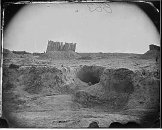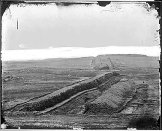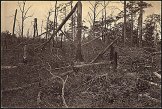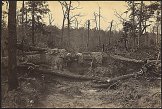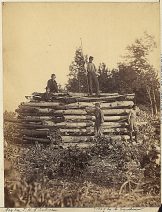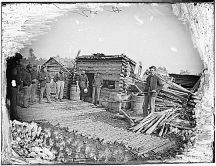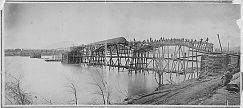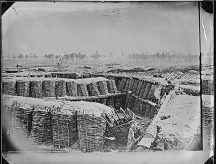The American Civil War: An Environmental View
Jack Temple Kirby, Miami University
©National Humanities Center |
|
(part 3 of 6)
|
National Archives 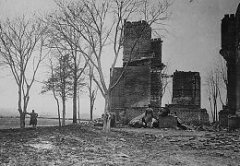 |
Ruins of rural house
|
|
 |
5. Farmland. Many battles took place on farms, and there,
too, horrible destruction of both built and arranged landscapes transpired. Farmhouses, barns, and other outbuildings were blown up, burned (often intentionally), or, if left standing, stripped of boards by needy troops of both sides. Farm fences everywhere disappeared, because they were conveniently sized and aged for firewood. Too, crop fields, which sometimes represented hard elemental labor by generations of proprietors (or, more likely, slaves), were remodeled, in effect, with breastworks, trenches, tunnels, and compacted paths, then littered with the dead, the deadís debris of belongings and equipment, and the wreckage of caissons, wagons, and other martial implements.
Some excellent farmland was forever lost—to military cemeteries and battlefield parks. Arlington National Cemetery was once a productive riverside plantation. One thinks also of Antietam in western Maryland, once pastoral, now an outdoor museum; of Gettysburg, where some of the bloodiest engagements have agrarian names—the Wheatfield, the Peach Orchard; and of Shiloh, now also a federal park that consumes in part excellent Tennessee riverbank lands. The Vicksburg siege and battles, on the other hand, took place on a landscape so hilly, so tortuously broken, that the most determined nineteenth-century agronomist —one thinks of Edmund Ruffin again since he was also the Southís premier soil scientist—might have gladly consigned the littered battlefield to the bizarre presentation of cemeteries, large marble memorials, and deeply ravined treescape that is the Vicksburg park today.
6. Trees and forests. Throughout the South and onto its northern and western fringes where war raged, farms were mere clearings, small ones, usually, in a vast forested landscape that also sustained enormous damage. Soldiers were forester-engineers nearly everywhere—felling trees, stripping limbs, chaining trunks to horses and mules for snaking to campsites and fortifications, where winter quarters and breastworks were almost always made of logs. Artillery fire, especially during sieges and set battles between large forces, also destroyed trees.
 |
|
|
| "Soldiers were forester-engineers nearly everywhere" |
|
|
|
 |
Sometimes—poetic retribution— trees killed or injured soldiers as the trees themselves were killed. An unlucky Massachusetts volunteer died felling trees for a fort west of Suffolk, Virginia, in October 1862. New York soldiers in the same campaign flinched as poorly aimed Confederate fire brought down tree branches upon their positions. It was fire, however—intentional and inadvertent—that doubtlessly consumed the most forested landscape, and sometimes men, too. The Battle of the Wilderness, west of Fredericksburg, Virginia, in 1864, is best known. Smoke from forest fires overwhelmed that from firearms and cannon, and wounded troops (not to mention horses and mules), caught in the holocaust, screamed as they were roasted alive.
TeacherServe Home Page
National Humanities Center
7 Alexander Drive, P.O. Box 12256
Research Triangle Park, North Carolina 27709
Phone: (919) 549-0661 Fax: (919) 990-8535
Revised: July 2001
nationalhumanitiescenter.org |



